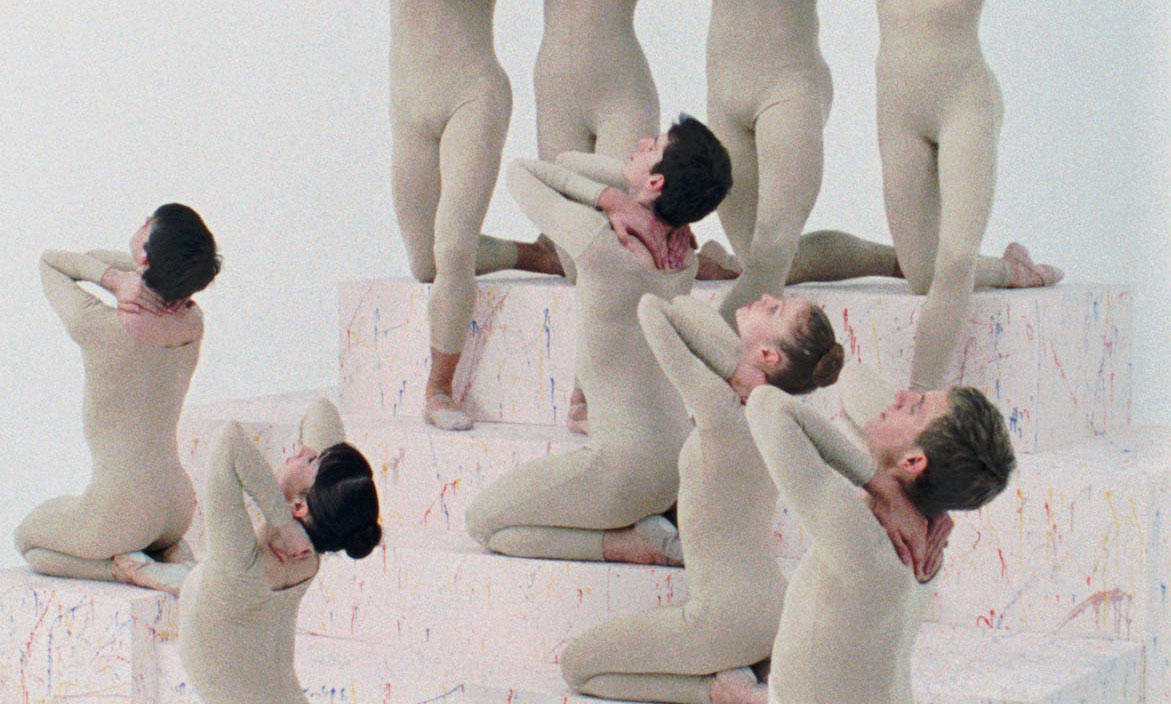
Elad Lassry’s most recent 16mm film — Untitled (Passacaglia), 2010 — begins with a slow and deliberate tracking shot across the surface of a garish and discordant painting. The painting, a pastiche of bright colors, evokes early twentieth-century Orphism, and even more specifically, appears to be a reproduction of Robert Delaunay’s 1916 oil-on-canvas work Tall Portuguese Woman. As the camera’s movement becomes increasingly unsympathetic to the logic of its subject — a rigid axial angularity at odds with the painting’s concentric circles — the image is reduced to an arrangement of geometric patterns. As it happens, Delaunay’s practice, and Orphism more broadly, maintained a consistent engagement with the task of translating sensorial phenomena into a singular contained image. Untitled (Passacaglia) takes this premise as its point of departure, and from there, proposes that in order to grasp the presence of an image, that image must first be reduced to nothing more than a filmic prop.
In the years immediately following the Second World War, another painter associated with Orphism, Fernand Léger, was appointed president of the newly established International Federation for Art Films, an organization jointly initiated by UNESCO, the International Council of Museums, and the Cinémathèque Française. The federation was intent on the use of film as a tool in the interpretation, appreciation, and popularization of the visual arts throughout the developing world. As both a painter and filmmaker, Léger seemed particularly suited to the task — the program set out to establish standards of quality for the cinematic documentation of important works of art. In the years that followed, filmmakers were sent to major international museums to capture the “essence” of paintings and sculptures for audiences unable to experience their wonders in the flesh. Films on art were commissioned en masse, and their proponents argued that the application of novel cinematic technologies could adequately convey that which is unavailable to the unassisted eye. Motion picture film, it seemed, was capable of lingering on static images so as to communicate their hidden properties, as if they revealed themselves over the duration of time.
Lassry’s interests are at least tangentially related to this lesser-known history, but his strategies also bear obvious resemblance to more recent developments in advanced art — an area where the fascination with images has been subsumed by the rhetoric of theory. The films of Michael Snow, Jack Goldstein, and Sharon Lockhart are, for Lassry, important points of comparison. While these artist-filmmakers are linked by an attraction to the mysteries of image production, their tendencies have been characterized as reflective of a structuralist impulse — a cinema of the mind rather than the eye, as it was once described by P. Adams Sitney. The remnants of structuralism are undeniably present in Lassry’s films, but a shorthand reliance on such categorical explanations loses sight of the transformation that occurs when one visual form mediates and communicates the properties of another. Untitled (Passacaglia) irresolutely fixates on the texture and quality of types of images that have long been the subjects of film but that have, nevertheless, remained relegated to their own medium-specific domains. Lassry’s films, to date, have been evocative of a structural concern, but they also reveal an awareness of the medium’s troubled relationship with its history as a form employed for the documentation and reproduction of other visual arts.
In this incarnation, Lassry’s fifteen-and-a-half-minute film departs from the legacy of the late American choreographer Doris Humphrey’s Passacaglia, which aired on National Education Television in 1966. While Lassry’s recreation of that event reflects the artist’s long-standing interest in the filmic documentation of modern dance, dance is only a tool for understanding how the processes of perception become visible when external forms of performance and visual art are translated by another visual medium. Much like his previous films, Untitled (Passacaglia) couches a preoccupation with dance in a thinly veiled disguise. It is true that dance has recently become an art world fetish. But above and beyond the particular context of dance, Lassry’s films on the subject insist upon the fundamental relationship between moving images and the visible world they attempt to capture. Untitled (Passacaglia) is perhaps concerned more with the image that dance offers of itself, than with the form’s peculiarities.
To produce this work, Lassry engaged performers from the New York City Ballet to recreate Humphrey’s radical work of modern choreography. When the reactionary piece was imagined in 1938, it defied convention and broke away from the rules of ballet. Lassry’s restaging is not a facsimile; the dancers’ repetitive movements become peripheral and their muted presence seems to obstruct the view of the patterned set that grounds the performance. Rather than privilege the dance, the camera’s focus is on the stage — risers splatter-painted in the style of California Drop Cloth’s ’70s-era “Celebration” upholstery, a signature textile pattern influenced by the drip paintings of Jackson Pollock. The performers’ bodies are awkwardly framed so as to resist any semblance of a total picture. It’s a tightly cropped scene with few dynamic edits; it denies a visual command of the dance and resists the filmic strategies of the original televised performance to which Lassry’s film refers. Eventually, in the film’s third and final vignette, the knockoff Delaunay painting reappears as a backdrop, in front of which three particularly iconic dancers pose uncomfortably, as if for an off-camera photo shoot. In the end, Lassry’s recasting of these original works of art is not tinged with irreverence or even art-historical critique.